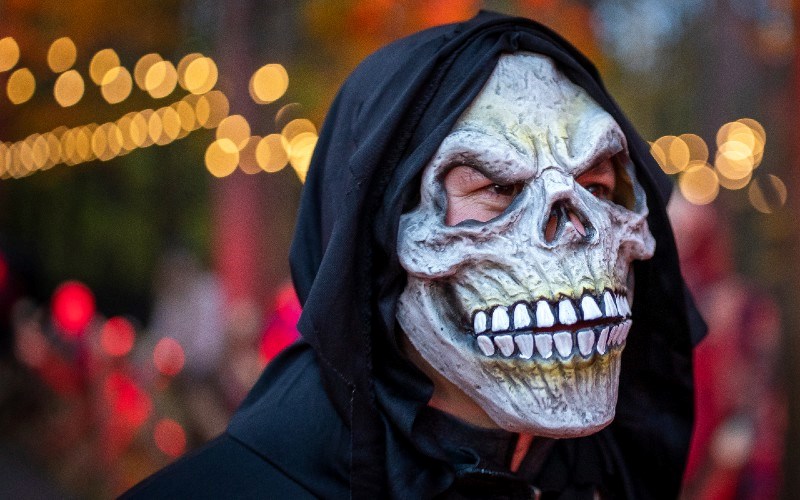Every year, Halloween gets bigger, earlier and creepier.
The box stores and folksy places like Cracker Barrel begin adding witch-themed stuff to their inventory in late August.
By late September, people's lawns have headstones, skeletons, vampires, goblins, ghosts and even grisly items like severed limbs and heads. Some of the home-made displays are quite ingenious.
On bushes and trees, strings of orange or purple lights mimic Christmas lights. Which raises a question: What are we all celebrating?
At Christmas, it's the birth of a Savior, goodwill toward men and the ultimate triumph of good over evil. God wins. The devil loses. Souls are won. Heaven and earth rejoice.
At Halloween, the focus is on death, occultism and nightmares. The devil couldn't be more pleased.
Before you tune out, saying, "Come on, lighten up and have a little fun," please read on.
Halloween can be a hoot. Costumes, trick or treat, carved pumpkins and all that are very festive.
When I was a child, I did my best to get the biggest candy haul I could. Now, we put out a pumpkin, hand out candy and enjoy seeing unbelievably cute little Taylor Swifts and pint-sized Spider-Men.
What I don't savor is the over-the-top magnitude of it all and the ever-increasing fascination with death and the macabre. What's up with that? I think the answer lies in what I call the "What About Bob?" theory.
In the 1991 comedy film, Richard Dreyfuss plays Leo Marvin, a conceited psychiatrist who is driven mad by new, paranoid patient Bob Wiley, played by Bill Murray.
In the office, after the doctor asks him what makes him really afraid, Bob performs an obviously staged Tourette's Syndrome outbreak, complete with profanity. Nonplussed, the doctor asks, "Why exactly are you doing this?"
"If I fake it, then I don't have it," Bob answers. "You know, it's the same with the cardiac arrest."
Bob suddenly pounds his chest and slumps to the floor. The doctor, who has seen it all, calmly asks him, "Are you married?"
The point here is that all the fakery about death and ghouls may be the equivalent of Bob fending off serious illness by the act of pretending.
This could also help explain Hollywood's fascination with evil and its lucrative outpouring of horror movies. Joking about murder and mayhem makes them less scary – usually.
I thought vampires were great fun until I saw "The Horror of Dracula" with Bela Lugosi on TV when I was about eight. For days, I crawled every night into my parents' bed. This got old for them real quick.
Anyway, the real world is frightening enough. The news is full of tragedy, like the Hamas terrorist attack on Israeli villagers or the mass murder this past week in Lewiston, Maine.
With the rise of artificial intelligence, fake news, internet porn, video game violence and drug abuse, the line between reality and fantasy is getting thinner by the day. It's almost as if someone out there wants to sow as much uncertainty as possible.
How else to explain the insane embrace of gender confusion by so many people? Or the notion that we can spend trillions to "bring down" inflation? Or that we can affect global weather by unilaterally strangling our energy industry? Or that blurring the line between good and evil in TV and movies won't have consequences? Madness.
Surveys show decreasing church attendance and a steady increase in the "nones" – people who identify as non-believers. Some of these folks, many of whom are quite bright, say they believe only in "science" and the material world, and that anything more is a self-serving fantasy.
In "The Screwtape Letters," C.S. Lewis's masterpiece, a senior devil, Screwtape, instructs junior demon Wormwood in how to corrupt a young man. The experienced tempter warns the imp not to let his subject actually believe in God or satanic powers. Instead, "'the Life Force,' the worship of sex, and some aspects of psychoanalysis, may here prove useful."
Further, he advises Wormwood to play up popular depictions.
"The fact that 'devils' are predominantly comic figures in the modern imagination will help you …. Suggest to him a picture of something in red tights, and persuade him that since he cannot believe in that (it is an old text-book method of confusing them) he therefore cannot believe in you."
Lewis warns further: "There are two equal and opposite errors into which our race can fall about the devils. One is to disbelieve in their existence. The other is to believe, and to feel an excessive and unhealthy interest in them."
The devil as a joke or as an obsession works either way.
The cure is not that complicated: acknowledging God's goodness and accepting His offer of salvation.
Seventeenth century poet and essayist Joseph Addison summed up the advantage afforded a person of faith:
"Should the whole frame of Nature round him break,
In ruin and confusion hurled,
He, unconcerned, would hear the mighty crack,
And stand secure amidst a falling world."
Indeed, Halloweens come and go. Hallelujahs go on forever.
This article appeared originally here.
Notice: This column is printed with permission. Opinion pieces published by AFN.net are the sole responsibility of the article's author(s), or of the person(s) or organization(s) quoted therein, and do not necessarily represent those of the staff or management of, or advertisers who support the American Family News Network, AFN.net, our parent organization or its other affiliates.








